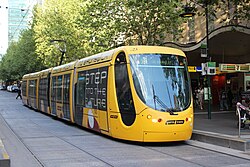|
Cross-city route
  A cross-city route is a public transport route linking one suburb (or satellite) of a city or town with another, usually relatively distant, suburb (or satellite). Such a route can be operated by various forms of public transport, including commuter rail, rapid transit, trams (streetcars), trolleybuses, or motor buses. Forms of cross-city routesThrough routesTypically, a cross-city route will be a combination of two radial routes, each linking one of the outer termini with the city or town's central business district (CBD). Such a route is sometimes called a through route. (Note: The term cross-city route is not used in American English, and the similar American English term crosstown route has a distinctly different meaning, referring to a transport route that does not serve the city centre and runs generally perpendicular to radial routes.) A public transport operator may combine radial routes into a through route because terminating a route in a city or town centre has certain disadvantages, including the following:[1]
On the other hand, there are certain advantages in terminating a route in a city or town centre:[1]
In most cases, the advantages of operating routes across a city or town centre outweigh the disadvantages,[1][2] but each case must be assessed on its own merits.[1] Other formsAnother form of cross-city route is a peripheral cross-city route, which links a pair of (usually distant) suburbs (or satellites) without passing through or close to the CBD.[2] Such routes are also referred to as tangential routes, because they follow a tangential path relative to the centre of a network.[3] In American English, peripheral cross-city routes are called crosstown routes. Although a public transport route that links nearby suburbs without passing through the CBD would fall within this description, such a route will commonly be set up, and better described, as a feeder route to either a radial route or a through route heading towards the CBD.[1] See alsoReferences
|